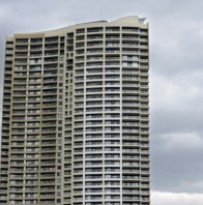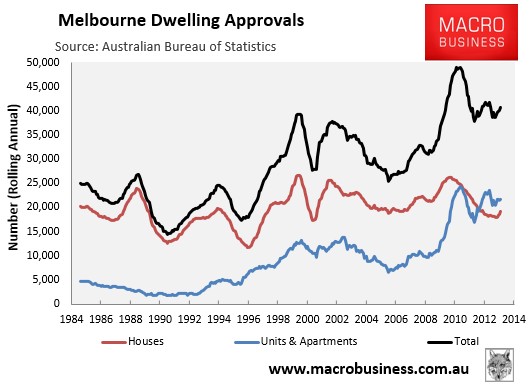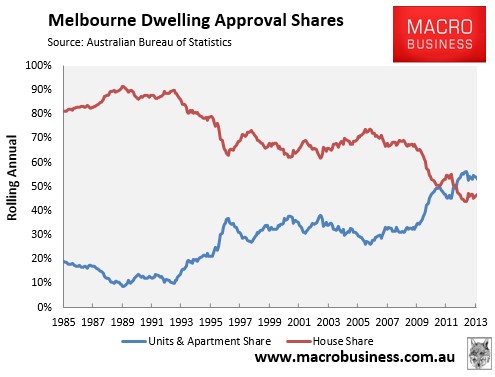
The Weekend AFR ran an article warning of the declining quality of high rise apartment developments in Melbourne, which are increasingly being built to satisfy the needs of international and local investors, rather than local families, leading to a proliferation of small sub-standard homes that risk becoming tomorrow’s slums:
Fears that Melbourne’s skyline will be scarred by high-rise hovels is forcing the state government to overhaul building controls to boost the design quality of apartments flooding into the central business district…
Apartment towers built too close together, bedrooms with no natural light or ventilation, cheap materials and badly designed buildings are creating sky-high slums that will cost future generations vast amounts to repair or replace, according to design experts…
Thousands of new apartments are due to become available in Melbourne’s inner-city this year.
…local and overseas investors are dictating the size, location and quality of inner-city apartments… [Developers] who typically need to pre-sell about 70 per cent of the value of a development to secure lending from banks, targeted rich overseas investors and local self-managed super funds
There is an interesting dichotomy developing across Melbourne’s housing market.
While overall construction levels are high, this is being driven predominantly by apartments, whose share recently rose above 50% for the first time (see below charts).


Meanwhile, the size of apartments has been shrinking making them unsuitable for most local buyers. According to recent reports in The AFR, the average size of an apartment five years ago was 60 square metres, whereas today it is between 42 and 45 square metres and falling. There are also frequent reports of many of the apartments sold to foreigners being kept empty.
In many ways, Melbourne’s housing market is increasingly being geared for “export” to foreign investors, as well as for local SMSFs, rather than meeting the needs of locals. As a result, the surge in apartment construction is failing to alleviate affordability pressures or perceived housing shortages, since the homes most locals demand remain in relatively short supply.
The risk is that with the low level of fundamental demand for high rise apartments, as well as the inherent long lead times between approval and completion (typically around three years), there is greater potential for a sharp slowdown and glut if/when investor demand evapourates.
Arguably, the situation developing in Melbourne is similar to what transpired in Ireland, where a large number of sub-standard homes were constructed in places where locals did not want to live (the so-called “ghost estates”), exacerbating the eventual downturn.

